![]()
Velázquez (or Velásquez), Diego (1599-1660). Spain's greatest painter was also one of the supreme artists of all time. A master of technique, highly individual in style, Diego Velasquez may have had a greater influence on European art than any other painter.
Diego Rodriguez de Silva Velasquez was born in Seville, Spain, presumably shortly before his baptism on June 6, 1599. His father was of noble Portuguese descent. In his teens he studied art with Francisco Pacheco, whose daughter he married. The young Velasquez once declared, "I would rather be the first painter of common things than second in higher art." He learned much from studying nature. After his marriage at the age of 19, Velasquez went to Madrid. When he was 24 he painted a portrait of Philip IV, who became his patron.
The artist made two visits to Italy. On his first, in 1629, he copied masterpieces in Venice and Rome. He returned to Italy 20 years later and bought many paintings--by Titian, Tintoretto, and Paolo Veronese--and statuary for the king's collection.
Except for these journeys Velasquez lived in Madrid as court painter. His paintings include landscapes, mythological and religious subjects, and scenes from common life, called genre pictures. Most of them, however, are portraits of court notables that rank with the portraits painted by Titian and Anthony Van Dyck.
Duties of Velasquez' royal offices also occupied his time. He was eventually made marshal of the royal household, and as such he was responsible for the royal quarters and for planning ceremonies.
In 1660 Velasquez had charge of his last and greatest ceremony--the wedding of the Infanta Maria Theresa to Louis XIV of France. This was a most elaborate affair. Worn out from these labors, Velasquez contracted a fever from which he died on August 6.
Velasquez was called the "noblest and most commanding man among the artists of his country." He was a master realist, and no painter has surpassed him in the ability to seize essential features and fix them on canvas with a few broad, sure strokes. "His men and women seem to breathe," it has been said; "his horses are full of action and his dogs of life."
Because of Velasquez' great skill in merging color, light, space, rhythm of line, and mass in such a way that all have equal value, he was known as "the painter's painter." Ever since he taught Bartolomé Murillo, Velasquez has directly or indirectly led painters to make original contributions to the development of art. Others who have been noticeably influenced by him are Francisco de Goya, Camille Corot, Gustave Courbet, Edouard Manet, and James McNeill Whistler. His famous paintings include The Surrender of Breda, an equestrian portrait of Philip IV, The Spinners, The Maids of Honor, Pope Innocent X, Christ at Emmaus, and a portrait of the Infanta Maria Theresa.
 Maria Teresa of Spain ("with two watches")
Maria Teresa of Spain ("with two watches")
Kunsthistorisches Museum, Vienna (80 Kb)
 The Dwarf Sebastian de Morra
The Dwarf Sebastian de Morra
(90 Kb); Museo del Prado, Madrid
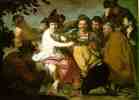 Los Borrachos (The Feast of Bacchus)
Los Borrachos (The Feast of Bacchus)
(150 Kb); Museo del Prado, Madrid
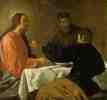 The Supper at Emmaus
The Supper at Emmaus
c. 1620 (100 Kb); Oil on canvas, 123.2 x 132.7 cm (48 1/2 x 52 1/4 in);
The Metropolitan Museum of Art, New York
 The Waterseller of Seville
The Waterseller of Seville
1623 (130 Kb); Oil on canvas, 106.7 x 81 cm (42 x 31 7/8 in);
Wellington Museum, London
 Philip IV
Philip IV
c. 1624-27 (90 Kb); Oil on canvas, 210 x 102 cm (82 3/4 x 40 1/8 in);
Museo del Prado, Madrid
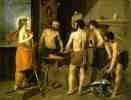 The Forge of Vulcan
The Forge of Vulcan
1630 (140 Kb); Oil on canvas, 223 x 290 cm (87 3/4 x 114 1/8 in);
Museo del Prado, Madrid; No. 1171
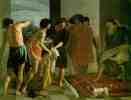 Joseph's Bloody Coat Brought to Jacob
Joseph's Bloody Coat Brought to Jacob
1630 (120 Kb); Oil on canvas, 223 x 250 cm (87 3/4 x 98 3/8 in);
Monastery of San Lorenzo de El Escorial
 The Count-Duke of Olivares on Horseback
The Count-Duke of Olivares on Horseback
1634 (140 Kb); Oil on canvas, 313 x 239 cm (123 3/8 x 97 1/8 in);
Museo del Prado, Madrid
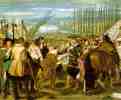 The Surrender of Breda
The Surrender of Breda
Before 1635 (180 Kb); Oil on canvas, 307 x 367 cm (10' 7/8" x 12' 1/2");
Museo del Prado, Madrid
 Pablo de Valladolid
Pablo de Valladolid
c. 1635 (100 Kb); Oil on canvas, 6'10 1/2" x 4'1/2";
Museo Prado, Madrid
 Aesop
Aesop
c. 1639-40 (100 Kb); Oil on canvas, 179 x 94 cm (70 1/2 x 37 in);
Museo del Prado, Madrid; No. 1207
 The Needlewoman
The Needlewoman
c. 1640 (140 Kb); Oil on canvas, 74 x 60 cm (29 1/8 x 23 5/8 in);
National Gallery of Art, Washington
 The Dwarf Francisco Lezcano, Called "El Nino de Vallecas"
The Dwarf Francisco Lezcano, Called "El Nino de Vallecas"
c. 1642-45 (130 Kb); Oil on canvas, 107 x 83 cm (42 1/8 x 32 5/8 in);
Museo del Prado, Madrid; No. 1204
 Innocent X
Innocent X
c. 1650 (120 Kb); Galleria Doria-Pamphili, Rome
 Juan de Pareja
Juan de Pareja
1650 (130 Kb); Oil on canvas, 81.3 x 69.9 cm (32 x 27 1/2 in);
The Metropolitan Museum of Art, New York
 Las Meninas (Maids of Honor)
Las Meninas (Maids of Honor)
1656-57 (120 Kb); Museo del Prado, Madrid
As court painter to Philip IV, Velazquez spent a large part of his life recording, in his cool, detached way, the objective appearance of this rigidly conventional royal household, with little interpretation but with the keenest eye for selecting what was important for pictoral expression and with a control of paint to secure exactly the desired effect. Through acquaintance, while in Italy, with the work of Caravaggio and through contact with the Spaniard Jusepe de Ribera (1588-1656), he learned something of the potentialities of a very limited palette, black and neutrals, as is evident in many of his portraits, which are subtle harmonies of grays and blacks.
In painting these royal portraits, whatever interpretation he made or whatever emotional reaction he experienced he kept to himself. Royalty, courtliness of the most rigid character was his task to portray, not individual personality. However, the portrait of Innocent X leads on to suspect that there might have been more interpretation had the painter been free to express it.
Through his practice of using pigment as it is used in Maids of Honor, and Innocent X, in short or long, thin or thick, apparently hasty and spontaneous but actually most skillfully calculated strokes, Velasquez was a forerunner of the modern practice or direct painting.
Photographs by Mark Harden and Carol Gerten-Jackson.